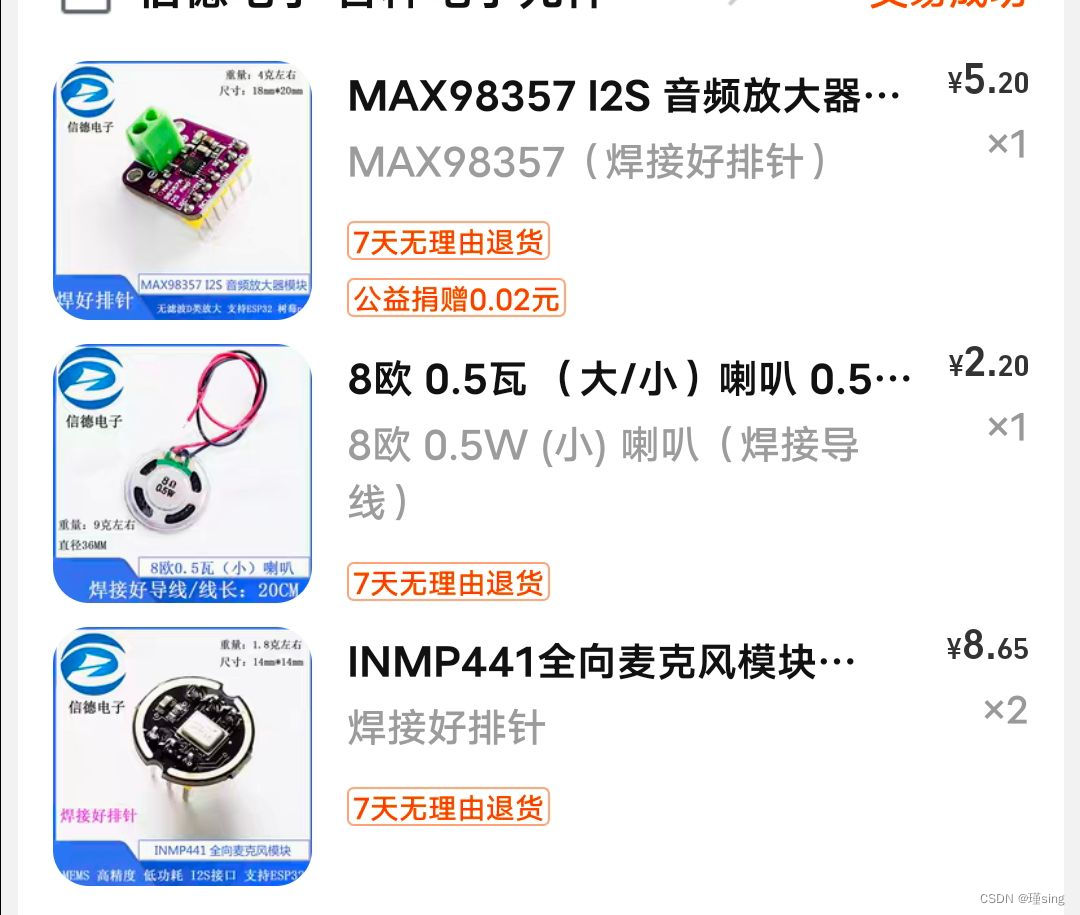esp32接入ai模型与经验分享
前言
本次用到的为arduino环境编写的。
先前我是用到Thonny,但其网络库在api请求时不支持重定向,而arduino库支持。
并且感谢博主 2345VOR (鹏哥) 其博客:
2345VOR
我的代码在他的基础框架进行修改的
实物

硬件准备
1.一块esp32
2.屏幕 1.8寸TFT彩屏(驱动芯片ST7735)
3.语音输入与输出部分
(货物清单在这)
4.杜邦线,面包线,led,按键,散热片(芯片发热量有点大)
库文件准备
1.首先要有编程环境(arduino)
2.安装esp32开发板管理
3.安装必要的库文件
#include <TFT_eSPI.h> //tft库
#include <U8g2_for_TFT_eSPI.h> //汉字库头文件,主要是它
#include <WiFi.h>
#include <ArduinoJson.h>
#include <HTTPClient.h>
#include "base64.h"
#include "cJSON.h" //网络请求与解析库
#include <driver/i2s.h>//语音输入输出库
#include "Audio.h"
(网络与解析库文件可以直接在arduino下载)
(<driver/i2s.h>库本身就包含了是i2s库的一个分支)
("Audio.h"库需要自己安装)esp32_audio库
(TFT_esoI.h可以直接在arduino下载)
(<U8g2_for_TFT_eSPI.h>库有博主提供了需要自己放在库文件下)
TFT汉字库
TFT屏幕的驱动设置
详细可以看b站视频驱动设置
我这里带大家简单操作下
1.打开对应的库文件 打开arduino文件夹
打开arduino文件夹 打开libaries文件夹
打开libaries文件夹 打开TFT_ESPI库文件夹
打开TFT_ESPI库文件夹 选择这个文件,进行屏幕驱动的选择
选择这个文件,进行屏幕驱动的选择 对于我这块屏幕是st7735驱动芯片驱动的
对于我这块屏幕是st7735驱动芯片驱动的
在对应的宏定义前解除注释就行
(驱动选择选完了之后就是引脚选择了)也在同样的文件下 这是我对应的引脚修改
这是我对应的引脚修改
这些做完之后便可以先用arduino上的TFT例程测试一下
(详细可以看视频)
API请求
推荐调试工具为 (postman)
本次用到的为KIMI的ai模型API(post请求)
kimiAPI官网
语音识别为百度智能云上面的云服务(post请求)
语音输出也是百度智能云上的云服务(get请求)
百度智能云平台官网
(这里得知道如何发送请求,与接收json格式的数据)
(以及注册api账户开启api服务,这会产生一些费用)
【由于篇幅原因,希望您可以去网上自行了解】
语音上传部分
一.语音数据采集
语音识别部分为driver/i2s.h库,麦克风部分为INMP441,具体用法
可以csdn上看其他博主的介绍,值得注意的是这个库虽然在声音信号上的
数据采集便利了,但其本身双声道库,一个左或者右麦克风只能采集一半的数
据量,举例:如果我是8k采样1600个16位数据,按理来说是采集2秒,但实际
上其接口函数只有前一半右数据(左声道),后一半(右声道)无数据都为0。
为了解决这个问题有两种方法
1.是数据增加到3200个,这样也是采样两秒(直接out)浪费资源
2.在接口函数填入数组大小是设置为两倍长度
二.数据上传部分
要将采集到的音频数据编码为base64才可上传到百度云,该上传代码
主要为2345VOR博主所提供
文字转语音
这个是我看到了其他博主的文章发现audio.h库刚好有函数接口可以播放
网络音乐(MP3格式),正好百度智能云的文字转语音用get方法获取也为
MP3格式,在游览器上试了下可以(这个不能用postman调试了),所以这
一部分库函数功能刚好实现
同时输出与输入音频文件
因为库的底层有冲突站用了同一个I2s,虽然说esp32的i2s资源有两个i2s1
与i2s2,我尝试了修改其库的底层让他们分别用不同的i2s,但还是会一直重
启报错(其实是冲突了),网上查了一下是虽然有两个i2s但其实还是同一个
也就是不能同时输出与输入
解决办法是:用到时候安装上对应的驱动,用完了再去卸载驱动,给另外
一个用,这样就不会冲突了
接线部分
语音输出(max98357)
#define I2S_DOUT 25
#define I2S_BCLK 27
#define I2S_LRC 26
max98357的接线端子还要接喇叭(正负不分)
语音输入(inmp441)
#define I2S_WS 32
#define I2S_SD 35
#define I2S_SCK 33
注意INMP441的 L/R接地
tft屏幕
#define TFT_MOSI 2
#define TFT_SCLK 15
#define TFT_CS 17
#define TFT_DC 16
#define TFT_RST 4
LED
#define ledPin 21 (接正极)
按键
#define keypin 18 (按键脚的另一端接地,且需要给18脚接个上拉电阻)
整个工程arduino源码
#include <TFT_eSPI.h> //tft库
#include <U8g2_for_TFT_eSPI.h> //汉字库头文件,主要是它
#include <WiFi.h>
#include <ArduinoJson.h>
#include <HTTPClient.h>
#include "base64.h"
#include "cJSON.h" //网络请求与解析库
#include <driver/i2s.h>//语音输入输出库
#include "Audio.h"
//json data
char data_json[43700]; //内存不大,只能录两秒钟,设置大了,会报错
//音频输出
#define I2S_DOUT 25
#define I2S_BCLK 27
#define I2S_LRC 26
//文字显示
U8g2_for_TFT_eSPI u8g2;
TFT_eSPI my_tft;
//WiFi
const char* ssid = "OK"; //你的WiFi名称
const char* password = "33333333"; //你的WiFi密码
//声音采集
//按照接线确定编号-----------------------------------------------------------------------------------------------------
#define I2S_WS 32
#define I2S_SD 35
#define I2S_SCK 33
// 使用I2S处理器
#define I2S_PORT I2S_NUM_0
// 定义缓冲区长度
#define bufferLen 16000
int16_t sBuffer[bufferLen]; //内存不大,只能录两秒钟,设置大了,会报错
//-------------------------------------------------------------------------------------------------------------------------
//kimi——api
String Kimi_url = "https://api.moonshot.cn/v1/chat/completions";
//百度文字转音频
String voice_url = "http://tsn.baidu.com/text2audio";
//文字显示函数
void TFT_print(uint16_t x,uint16_t y,String Text,uint16_t TextColor,uint8_t Size)
{
switch(Size)
{
case 1:
u8g2.setFont(u8g2_font_wqy12_t_gb2312); //12像素大小
break;
case 2:
u8g2.setFont(u8g2_font_wqy16_t_gb2312); //16像素大小
break;
}
u8g2.setForegroundColor(TextColor); //字的颜色
u8g2.setCursor(y, x); //位置
u8g2.print(Text); //打印
}
//——————————————————————————————————————————————————————————————————————————————————————————————————————————麦克风驱动安装的函数---------------------------------
void i2s_install() {
//设置I2S处理器配置
const i2s_config_t i2s_config = {
.mode = i2s_mode_t(I2S_MODE_MASTER | I2S_MODE_RX),
.sample_rate = 8000,
.bits_per_sample = i2s_bits_per_sample_t(16),
.channel_format = I2S_CHANNEL_FMT_ONLY_LEFT,
.communication_format = i2s_comm_format_t(I2S_COMM_FORMAT_STAND_I2S),
.intr_alloc_flags = 0,
.dma_buf_count = 8,
.dma_buf_len = 64,
.use_apll = false
};
i2s_driver_install(I2S_PORT, &i2s_config, 0, NULL);
}
void i2s_setpin() {
// 设置I2S引脚配置
const i2s_pin_config_t pin_config = {
.bck_io_num = I2S_SCK,
.ws_io_num = I2S_WS,
.data_out_num = -1,
.data_in_num = I2S_SD
};
i2s_set_pin(I2S_PORT, &pin_config);
}
//-------------------------------------------------------------------------------------------------------------------------------------------------------------
//---------------------------------------------------------------ai回答部分(接入kimi)------------------------------------------
String get_kimi(String question)
{
HTTPClient http1 ;
http1.setTimeout(20000);
http1.begin(Kimi_url);
http1.addHeader("Content-Type", "application/json");
http1.addHeader("Authorization", "sk-4cyiL5............................................................."); //注意得填写你的码
String body="{\"model\":\"moonshot-v1-8k\",\"messages\":[{\"role\":\"system\",\"content\":\"你是我的AI助手小南,你必须用中文回答且字数不超过85个\"},{\"role\":\"user\",\"content\":\"" + question + "\"},{\"role\": \"assistant\",\"name\":\" 小南\", \"content\":\"\", \"partial\": true}],\"temperature\":0.3}";
int httpResponseCode = http1.POST(body);
if(httpResponseCode == 200)
{
String response = http1.getString();
http1.end();
//Serial.println(response);
StaticJsonDocument<1024> json1;
deserializeJson(json1,response);
String json_get1 = json1["choices"];
deserializeJson(json1,json_get1);
String message = json1[0]["message"].as<String>();
deserializeJson(json1,message);
String respone = json1["content"];
//Serial.println(respone);
return respone ;
}
else
{
http1.end();
//Serial.println("error");
return "你问的太快了询问不能频繁当前为一分钟三到四次询问)";//(kimi的api比较菜一分钟只能问他3个问题)
}
}
//---------------------------------------------------------------------------------------------------------------------------------------------------------------------------
String Voice_2_Text(); // 语音转文字的函数
#define ledPin 21
#define keypin 18
void setup()
{
// put your setup code here, to run once:
Serial.begin(115200);
WiFi.mode(WIFI_STA);
pinMode(ledPin, OUTPUT); //led初始化
pinMode(keypin, INPUT); //按键初始化
digitalWrite(ledPin,HIGH); //开始时,亮灯
my_tft.init(); //初始化
u8g2.begin(my_tft); //将U8g2绑定到TFT
my_tft.setRotation(2); //屏幕旋转方向(可自行修改)
my_tft.setTextColor(TFT_DARKGREEN); //设置屏幕字颜色(用到了字库的话本句没用)
my_tft.fillScreen(TFT_BLACK); //屏幕背景
i2s_install(); //麦克封初始化---安装驱动
i2s_setpin();
i2s_start(I2S_PORT);
TFT_print(80,3,"Voiceinput (inx441) " ,TFT_YELLOW,1);
delay(150);
i2s_driver_uninstall(I2S_PORT); // 驱动卸载 (因为输出输入不能同时有,连个库的底层对应一个i2s,用到的时候在安装)
//audio.setPinout(I2S_BCLK, I2S_LRC, I2S_DOUT);
//audio.setVolume(12); // 0...21
//audio.connecttohost(""); //语音输出驱动(不能在全局定义,应为没有对应的释放接口,只能在局部变量中使用,否则esp32一直重启)
TFT_print(90,3,"Voiceinput (out) " ,TFT_YELLOW,1);//屏幕打印信息
delay(100);
WiFi.begin(ssid, password); //WiFi连接
uint8_t i = 1 ;
TFT_print(10,1,"WiFi is connecting....",TFT_WHITE,1);
while (WiFi.status() != WL_CONNECTED) {
TFT_print(20,i*5+1,".",TFT_WHITE,1);
delay(800);
i++;
if(i>=25)
{
TFT_print(30,1,"WiFi can`t conect ",TFT_RED,1);
TFT_print(40,1,"please check and again",TFT_RED,1);
while(1){}
}
}
digitalWrite(ledPin,LOW);
String ip = WiFi.localIP().toString().c_str();
TFT_print(30,1,"WiFi is connected",TFT_DARKGREEN,1);
TFT_print(40,1,"IP:" + ip ,TFT_DARKGREEN,1);
TFT_print(50,1,"Welcome:" ,TFT_WHITE,1);
TFT_print(60,3,"The api is kimi" ,TFT_WHITE,1);
TFT_print(70,3,"the character is CoNan" ,TFT_WHITE,1);
delay(1500);
my_tft.fillScreen(TFT_BLACK);
}
uint8_t voice_flag = 0 ;//是否有语音生成的状态值
String voic_get; // 文字转语音用到的get网址
void loop()
{
bool VAL_KEY = digitalRead(keypin);
TFT_print(10,1,"Answer:(空闲中) ",TFT_DARKGREEN,1);
if (VAL_KEY ==LOW)
{
delay(500);
String str_error = "error" ;
String get = Voice_2_Text();
if(get.compareTo(str_error) !=0)
{
Serial.println(get);
// inputText.trim();
my_tft.fillScreen(TFT_BLACK);
TFT_print(10,1,"Answer:(思考中)",TFT_RED,1);
Serial.println("\n Input:"+get);
String answer = get_kimi(get);
Serial.println("Answer: " + answer);
Serial.println("Enter a prompt:");
TFT_print(10,1,"Answer:",TFT_WHITE,1);
uint16_t len = answer.length();
uint16_t i =0;
uint16_t j =0;
TFT_print(10,1,"Answer:(交谈中) ",TFT_YELLOW,1);
for(i=0;i<len;i=i+30)
{
uint16_t k=0;
for(k=0;k<30;k=k+3)
{
TFT_print(22+j,5+(k/3)*12, answer.substring(i+k,i+k+3),TFT_WHITE,1);
delay(15);
}
//TFT_print(22+j,5, answer.substring(i,i+30),TFT_WHITE,1);
j+=15;
delay(15);
}//屏幕一个字一个字的显示的遍历
voic_get = voice_url + "?tex=" + answer +"&lan=zh&cuid=2579527033&ctp=1&tok=24.d9c2c.........................&per=111";//+号的&tok=...后面的部分得填写你的tok码
delay(20);
voice_flag = 1;
}else
{
TFT_print(10,1,"Answer:(出错了) ",TFT_RED,1);
TFT_print(25,1,"服务器端错误 ",TFT_YELLOW,1);
}
Serial.println("voice_flag is:");
Serial.println(voice_flag);
}
if(voice_flag == 1)
{
voice_flag = 0;
Audio audio;
audio.setPinout(I2S_BCLK, I2S_LRC, I2S_DOUT);//安装驱动
audio.setVolume(12); // 0...21 设置音量大小
const char* voice_url = voic_get.c_str(); //转化数据类型
audio.connecttohost(voice_url); //get请求网络上百度云生成的语音数据
TFT_print(10,1,"Answer:(空闲中) ",TFT_DARKGREEN,1); //屏幕显示
while(1)
{
audio.loop(); //循环播放
VAL_KEY = digitalRead(keypin); //检测按键值
if(VAL_KEY ==LOW )
{
break; //按下时为退出
}
}
}
}
//--------------------------------------------语音识别函数--------------------------------------------------------------
String Voice_2_Text()
{
//安装麦克风驱动-------------------------------
i2s_install(); //麦克封初始化
i2s_setpin();
i2s_start(I2S_PORT);
//-----------------------------------------------
memset(data_json, '\0', strlen(data_json)); //将数组清空
TFT_print(10,1,"Answer:(聆听中) ",TFT_BLUE,1);
size_t bytesIn = 0;
digitalWrite(ledPin,HIGH);
esp_err_t result_voice = i2s_read(I2S_PORT, &sBuffer, 2*bufferLen, &bytesIn, portMAX_DELAY); //应为该函数是用的左右声道同时采集,我们只有一个声道,所以告诉函数采用长度为实际数据的两倍数据长度,这样就可以将所有数据填满
// result = i2s_read(I2S_PORT, &sBuffer, 2*bufferLen, &bytesIn, portMAX_DELAY);
if (result_voice == ESP_OK)//采样完成标志位
{
TFT_print(10,1,"Answer:(识别中) ",TFT_BLUE,1);
digitalWrite(ledPin,LOW);
i2s_driver_uninstall(I2S_PORT);//麦克封驱动卸载
Serial.println("驱动卸载");
strcat(data_json, "{");
Serial.println("json写入");
strcat(data_json, "\"format\":\"pcm\",");
delay(10);
Serial.println("json写入1");
strcat(data_json, "\"rate\":8000,");
Serial.println("json写入2"); //采样率 如果采样率改变了,记得修改该值,只有16000、8000两个固定采样率
strcat(data_json, "\"dev_pid\":1537,");
Serial.println("json写入3"); //中文普通话
strcat(data_json, "\"channel\":1,");
Serial.println("json写入4"); //单声道
strcat(data_json, "\"cuid\":\"2579527033\",");
Serial.println("json写入5"); //识别码 随便打几个字符,但最好唯一
strcat(data_json, "\"token\":\"24.d9c2c44461f80b0.....................................................\","); //这里填写你的tok码
Serial.println("json写入6"); //token 这里需要修改成自己申请到的token
strcat(data_json, "\"len\":32000,");
Serial.println("json写入7"); //数据长度 如果传输的数据长度改变了,记得修改该值,该值是ADC采集的数据字节数,不是base64编码后的长度
strcat(data_json, "\"speech\":\"");
Serial.println("json写入8");
delay(20);
strcat(data_json, base64::encode((uint8_t*)sBuffer, sizeof(sBuffer)).c_str()); //base64编码数据
delay(20);
Serial.println("json写入9");
strcat(data_json, "\"");
Serial.println("json写入10");
strcat(data_json, "}");
Serial.println("json以安好");
int httpCode;
HTTPClient http2;
http2.setTimeout(5000); //设置超出响应时间
http2.begin("http://vop.baidu.com/server_api"); //https://vop.baidu.com/pro_api 语音转文字api
http2.addHeader("Content-Type", "application/json");
httpCode = http2.POST(data_json);
Serial.println("json以发送");
if (httpCode == 200)
{
if (httpCode == HTTP_CODE_OK)
{
Serial.println("接收正确");
String response = http2.getString();
http2.end();
Serial.println(response);
DynamicJsonDocument jsonDoc(1024);
// Parse JSON response
// DynamicJsonDocument jsonDoc(512);
deserializeJson(jsonDoc, response);
String question = jsonDoc["result"][0];
// 访问"result"数组,并获取其第一个元
// 输出结果
Serial.println(question);
return question ;
} else {
Serial.printf("[HTTP] GET... failed, error: %s\n", http2.errorToString(httpCode).c_str());
return "error" ;
}
}
else
{
Serial.println("接收有误区");
return "error";
}
}
}
//---------------------------------------------------------------------------------------------------------
存在的问题
我只是把他基本功能完成了,还有很多地方可以优化,且到了晚上开机第一次
使用时都是报错,之后就可以用了。如果您有什么好的办法与优化欢迎留言。
版权归原作者 瑾sing 所有, 如有侵权,请联系我们删除。